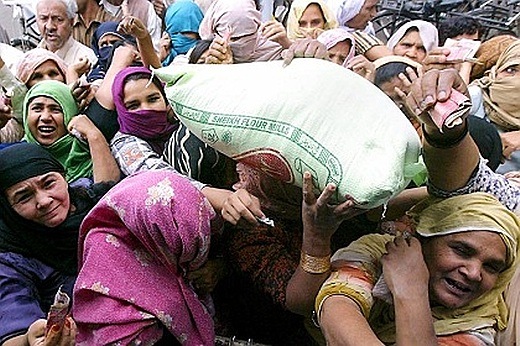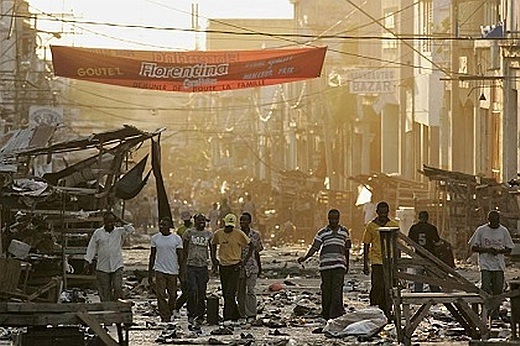SUBHEAD: Food prices have come down from their extraordinary heights in 2008, but they are much higher than just a few years ago.
By Magdoff and Brian Tokar in July 2009 issue of Monthly Review -
http://monthlyreview.org
[Editor's Note: this is the opening of the overview article for the current MR issue of Agriculture and Food in Crisis: Conflict, Resistance, and Renewal linked above. All images are from world-wide food crisis in 2008 recorded by www.Spiegel.de]
“Could Food Shortages Bring Down Civilization?,” asks the title of an article by Lester Brown in Scientific American (May 2009). Just a few years ago, such a question would have seemed almost laughable. Few will be surprised by it today.

image above: Pakistani women buy subsidized flour in Lahore. The price of staple foods and fuel has risen drastically in the country in the last few months. Many people in Pakistan are now dependent on state subsidies. From http://www.spiegel.de/fotostrecke/fotostrecke-30613-2.html
In 2008 people woke up to a tsunami of hunger sweeping the world. Although the prospect of rising hunger has loomed on the horizon for years, the present crisis seemed to come out of the blue without warning. Food riots spread through many countries in the global South as people tried to obtain a portion of what appeared to be a rapidly shrinking supply of food, and many governments were destabilized.The causes for the extraordinary spike in food prices in 2008, doubling over 2007 prices, brought together long-term trends, at work for decades, with a number of more recent realities.1 The most important long-term trends leading to current situation include:
• Increased diversion of corn grain and soybeans to produce meat as the world’s per capita meat consumption doubled in about forty years. As much as 95 percent of calories are lost in the conversion of grain and soybeans to meat.
• Decreased food production associated with poor countries adopting the neoliberal paradigm of letting the “free market” govern food production and distribution;
• Widespread “depeasantization,” partially caused by neoliberal “reforms” and International Monetary Fund (IMF) mandated “structural adjustments,” as conditions forced peasant farmers off the land and into urban slums, where one-sixth of humanity now lives; and increasing concentration of corporate ownership and control over all aspects of food production, from seeds, pesticides, and fertilizers, to the grain elevators, processing facilities, and grocery stores.2
One of the more recent causes for the crisis is the diversion of large amounts of corn, soy, and palm oil into producing agrofuels, the term adopted by critics worldwide for industrial-scale biofuels based on agricultural crops as feedstocks. Agrofuel production looked very appealing as the United States and the European Union sought to break the influence of oil producing countries and promote “greener” fuels (which are actually not particularly “green”).3
In 2008 some 30 percent of the entire corn crop in the United States was used to produce ethanol to blend with gasoline to fuel cars. Estimates of how much ethanol production contributed to the rise in food prices varied from less than 5 percent, according to the U.S. Department of Agriculture, to upwards of 80 percent, as estimated by the World Bank.
The year 2008 also brought major crop failures, from Bangladesh to the grain exporting regions of Australia, where wheat and rice crops were devastated by drought. Scientists agree that such widespread disruptions in food production will only increase with the increasing destabilization of the earth’s climate (see discussion below).
In addition, speculation at the local level (usually called hoarding) and unprecedented financial speculation in world commodity markets — an increasingly popular way to gamble as global stock markets plummeted — forced prices to much higher levels than they would have reached otherwise. With global food stocks at very low levels after several years in which consumption exceeded supply, crop failures in a few countries, and the new large-scale diversions of food into fuel production — combined with the longer-term trends — a “perfect storm” was created in which many people suffered greatly, and continue to suffer.
Although food prices have come down from their extraordinary heights of the summer of 2008, they are still considerably higher than just a few years ago. And food supplies, although ample to feed everyone if distributed equally, are still in relatively short supply. Today, approximately a billion people — close to one-sixth of humanity — suffer from continual and severe hunger. There are many more, possibly another two billion, who live in perpetual food insecurity — missing some meals and often not knowing where their next meal will come from. This means that close to half of all humans are either perpetually hungry and malnourished or suffering from varying degrees of food insecurity.
In the United States, even before the economic crisis that began in 2007 and the rapid rise in food prices in 2008, there were approximately 36 million living in hunger and food insecurity — an incredible 12 percent of the population without secure access to food in the richest country in the world, despite vast food production and ample supplies. Seventeen percent of its children under five years old, some 3.5 million, are estimated to be at high risk of cognitive and developmental damage as a result of inadequate nutrition due to hunger.4 This travesty occurring in the United States pales in comparison to the horrible conditions in the poorer regions of the world.
What are the prospects for the future? Are they really as dire as Lester Brown suggests? As we write this, a severe recession has set in around the world — deep and, perhaps, long lasting. It has already resulted in much more hunger and food insecurity in the United States and many other countries. How much worse can things get? Probably quite a bit, is the unfortunate answer.
Hungry for Profit
Many of the trends discussed ten years ago in the summer issue of Monthly Review, Hungry for Profit: The Agribusiness Threat to Farmers, Food, and the Environment (later issued in book form5) continue to this day:
• The disruption of nutrient cycles with the spread of capitalist agriculture and the more recent move toward large-scale, factory-style animal production facilities;
• The ecological damage caused by chemical- and fossil fuel-intensive agricultural practices;
• The great extent of consolidation (both horizontal and vertical integration) in the input and processing sectors of the agrifood system;
• Farmers increasingly working as laborers for agribusiness, often under contract to large integrated meat-producing corporations;
• The role of genetically modified (GM) seeds in consolidating corporate control over the input sector and farm practices overall;
• The difficulties presented to the third world by the various provisions of the World Trade Organization;
• The mass migration of peasants from the countryside of the third world (depeasantization), and into urban slums where there are few jobs available;
• The extent of hunger amidst plenty in the United States, with many anti-hunger organizations focusing on the most immediate emergencies, thus leaving the deeper issue of poverty unaddressed;
• The importance of land reform and the benefits of reducing or eliminating reliance on commercial fertilizers and pesticides;
• The resulting emergence of organizations within the United States and worldwide that are not satisfied with the system and are working to develop new solutions to feed communities and protect the land.

image above: In Manila, the capital of the Philippines, soldiers stand guard during the sale of government rice. With the price of rice soaring, the government is looking at ways to ensure none of its citizens starve. From http://www.spiegel.de/fotostrecke/fotostrecke-30613-3.html
Things have changed in the course of the last decade, of course. However, the basic trends continued and have become deeper and more ingrained in the system. For example, the many ecological disasters associated with conventional agricultural production have only gotten worse. These include pollution of groundwater and surface water with nitrates, phosphates, sediments, and pesticides; contamination of food; nutrient depletion on farms that raise crops, even while nutrient-rich wastes accumulate to dangerously polluting levels in large-scale animal production facilities; and increasing spread of antibiotic resistant microbes due to the routine use of antibiotics in factory-raised livestock.
The main driving force of the agrifood system is, of course, the never ending goal of continual generation of profits. Little appears to stand in the way of a system that worships, as Rachel Carson put it, the “gods of profit and production.”
The Current Situation
This issue of Monthly Review has two parts: the first deals with the history, politics, and economics of the food and agriculture crisis — how it developed and its characteristics in selected countries. Articles in this issue by Philip McMichael, Walden Bello and Mara Baviera, Utsa Patnaik, Sophia Murphy, and Deborah Fahy Bryceson offer a mix of historical and contemporary outlooks on the underlying roots of the crisis, as seen from a variety of international perspectives.
The second part of this issue discusses the possibilities for improving systems of food and farming as well as attempts to develop more secure food supplies for all people. David Pimentel addresses questions concerning energy and agriculture while Miguel Altieri discusses better ways to grow crops, organize production, and feed people. Christina Schiavoni and William Camacaro describe how Venezuela is working to reach food sovereignty, and articles by Peter Rosset and Eric Holt-Giménez explore the struggle for food through social movements and the push for meaningful land reform.
Farming, the process of growing food and fiber crops and raising food animals, is imbedded in a larger system, often referred to as the agrifood system. This system includes all the “upstream” inputs into farming (seeds, fertilizers, pesticides, tractors, fuel, implements, and so on) as well as the “downstream” sectors (purchasing farmers’ products, processing, transporting, wholesaling, and finally retailing at markets and restaurants).
While everyone eats food, the share of the population that is directly involved in its production declined precipitously in the industrial world during the twentieth century. A century ago, a third of the U.S. population, some 32 million people, lived on farms.6 At the beginning of the Great Depression, there were some 6.8 million farms in the United States.7 By the early 1960s this number was reduced by half — today there are only 1.3 million farms that earn more than $1,000 per year.8 There are more prisoners (2.3 million) than farmers in the United States today. At the same time, hundreds of millions of people are still engaged in farming in the countries of Africa, Asia, and Latin America — it is estimated that there are about 1 billion farmers out of a total world population of over 6 billion people.

image above: Food prices in Haiti are reported to have risen by 50 to 100 per cent in the last year, hitting the vast majority of the population -- who live on less than $2 a day -- particularly hard. From http://www.spiegel.de/fotostrecke/fotostrecke-30613-7.html
Biotech Crops
For the last fifteen years, corporations have aggressively promoted the idea that the genetic engineering of crops and seeds is the key to improving world agriculture. It is clear, however, that crops that have been genetically modified, usually by introduction of genes from other species, have so far produced no reliable increase in yields over equivalent non-GM crops.9
Since the first commercial production of GM crops in the late 1990s, opposition to this technology has united small-scale farmers, environmentalists, and public health advocates from India to southern Africa, as well as Western Europe and the United States. While over 300 million acres worldwide are currently planted in GM crops, according to industry sources, this represents only 2.6 percent of cultivated land, and is highly concentrated in North and South America. While GM acreage in China and India is expanding, most of the world’s croplands are still GM-free.10
Nearly all of the commercially grown GM crops are of two general types: either they are engineered to withstand large doses of chemical herbicides (for example, Monsanto’s well-known “Roundup Ready” varieties), or they produce one or more pesticidal proteins, derived from Bt (Bacillus thuringiensis) bacteria. Recently released varieties combine both traits, a technology known as “gene stacking.” Twenty years of claims that genetic engineering will “feed the world” by making crops more resilient and healthier have time and again proved false.
Instead, companies like Monsanto focus their research and development on traits that increase farmers’ dependence on proprietary chemicals, while making farming more logistically convenient, hence easier to carry out over larger acreages in increasingly mechanized farms.
While comprehensive analyses of the health and environmental effects of GM crops remain relatively sparse, scientists continue to reveal new information demonstrating that the technology is inherently disruptive of cellular metabolism and gene expression.11
Independent research is largely stifled by proprietary control over GM traits by companies that have every interest in suppressing systematic studies of the technology’s consequences, and independent plant breeding research at the state Land Grant universities in the United States is being largely supplanted by in-house corporate research.12
Corporate influence is exacerbated by an increasingly cozy relationship between these institutions and agribusiness corporations; for example, the president of South Dakota State University, David Chicoine, joined Monsanto’s Board of Directors, and is slated to receive significantly more income in 2009 than the $300,000 salary he receives from his University.13
Seed corporations have thoroughly corrupted the land grant university mission — directly through research grants and payments to consulting scientists, and indirectly by prohibiting most independent research on GM seeds.
No comments :
Post a Comment